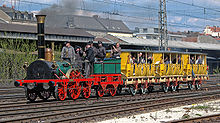2-2-2

Under the Whyte notation for the classification of steam locomotives, 2-2-2 represents the wheel arrangement of two leading wheels on one axle, two powered driving wheels on one axle, and two trailing wheels on one axle. The wheel arrangement both provided more stability and enabled a larger firebox than the earlier 0-2-2 and 2-2-0 types. This wheel arrangement is sometimes described as a Single, although this name could be used to describe any kind of locomotive with a single pair of driving wheels.
Equivalent classifications
Other equivalent classifications are:
- Italian classification)
- French classification: 111
- Turkish classification: 13
- Swiss classification: 1/3
History
The 2-2-2 configuration appears to have been developed by
Eighteen of the first nineteen locomotives ordered by Isambard Kingdom Brunel for the opening of the Great Western Railway in 1837/8 were of the 2-2-2 type.[4] These included six 2-2-2 locomotives built by Charles Tayleur at his Vulcan Foundry. Also in 1837 the successful North Star broad gauge locomotive was delivered to the Great Western Railway by Stephenson, becoming the first of a class of twelve locomotives by 1841.

Later UK developments
The Great Western Railway continued to order both broad gauge and standard gauge locomotives on the railway, including the Firefly and Sun classes (1840–42), which were enlarged versions of North Star. Bury, Curtis and Kennedy supplied six 2-2-2 locomotives to the Bristol and Gloucester Railway in 1844, and fourteen to the Great Southern and Western Railway in Ireland in 1848, (the last of these has been preserved at Cork Kent railway station.

The
Although by the 1860s the 2-2-2 configuration was beginning to be superseded by the
Belgium

The first steam railway locomotive built in Belgium in 1835, and was built by
Italy
Two 2-2-2 locomotives were imported from Longridge and Co of Bedlington Ironworks England for the Naples–Portici railway in 1839 named Bayard and Vesuvio. A replica of 'Bayard is at the Naples Railway Museum.[11]
Germany
Most of the earliest locomotives to operate in what is now Germany before the mid-1840s were 2-2-2s delivered by UK manufacturers. However, by 1839 the type was also being built locally see
Austria
The
Latvia
One of last 2-2-2 tank locomotives were ordered by Latvian Railways, for local traffic. The locomotives Tk class were designed by German Hohenzollern, and 20 were manufactured in Germany and Latvia in 1928-1934.[13] They were next seized by Soviet railways. After World War II one served in Poland as OKa1 class.[13]


Preserved examples and replicas
- A replica of Adler of 1835
- A replica of North Star of 1837
- A replica of Arend of 1839
- A replica of Odin of 1846 (constructed at Roskilde roundhouse between 2004-2018)
- LNWR No 1868 (formerly named Columbine) built 1845
- The LNWR 2-2-2 3020 Cornwall built 1847
- GS&WR Bury No. 36 of 1848, on display at Cork Kent railway station in Ireland
- CVRR 2-2-2, Pioneer, built by the Union Works, Boston Massachusetts, 1851. Held by the Smithsonian
- The East Indian Railway No. 22, also known as "Fairy Queen" is a 2-2-2T built in 1855 for the East Indian Railway. It still operates for them today, making it the oldest operating steam locomotive in the world in regular service.
- BBÖ Class 12 locomotive of 1937
- CP 1 - D Luiz I, a 2-2-2 locomotive, built by Entroncamentoyard together with the Royal Train wagons.
- Railway Museum in Warsaw[13]
External links
- GNR No. 229, photographed around 1900
- Winchester, Clarence, ed. (1936), "Some famous singles", Railway Wonders of the World, pp. 1091–1099 illustrated description of some famous singles
References
- ^ Hamilton Ellis, The pictorial encyclopaedia of railways, Hamlyn, 1968, p.37.
- ^ Ellis, The pictorial encyclopaedia of railways, p.37.
- ^ Science Museum, The British Railway Locomotive 1803-1853, H.M.S.O, 1958, p.13.
- ISBN 0-901115-32-0.
- ^ D.L. Bradley, Locomotives of the London Brighton and South Coast Railway, Part 1, Railway Correspondence & Travel Society, 1969, p.36.
- Railway Correspondence & Travel Society. p. D15.
- ^ Tabor 1956, p. D19
- ISBN 0-901115-18-5.
- ^ "La Construction des LOCOMOTIVES à VAPEUR en Belgique". www.tassignon.be (in French).
- ^ "La loco à vapeur de Vresse-sur-semois". home.scarlet.be (in French).
- ^ "The Naples Railway Museum". www.internationalsteam.co.uk. Retrieved 13 April 2018.
- ^ Christopher Chant, 'The World's Railways, Regency House Publishing (2001)1552671607
- ^ a b c Altbergs, Toms. The Latvian Tk tanks, "Locomotives International" No.101, p. 54-56
